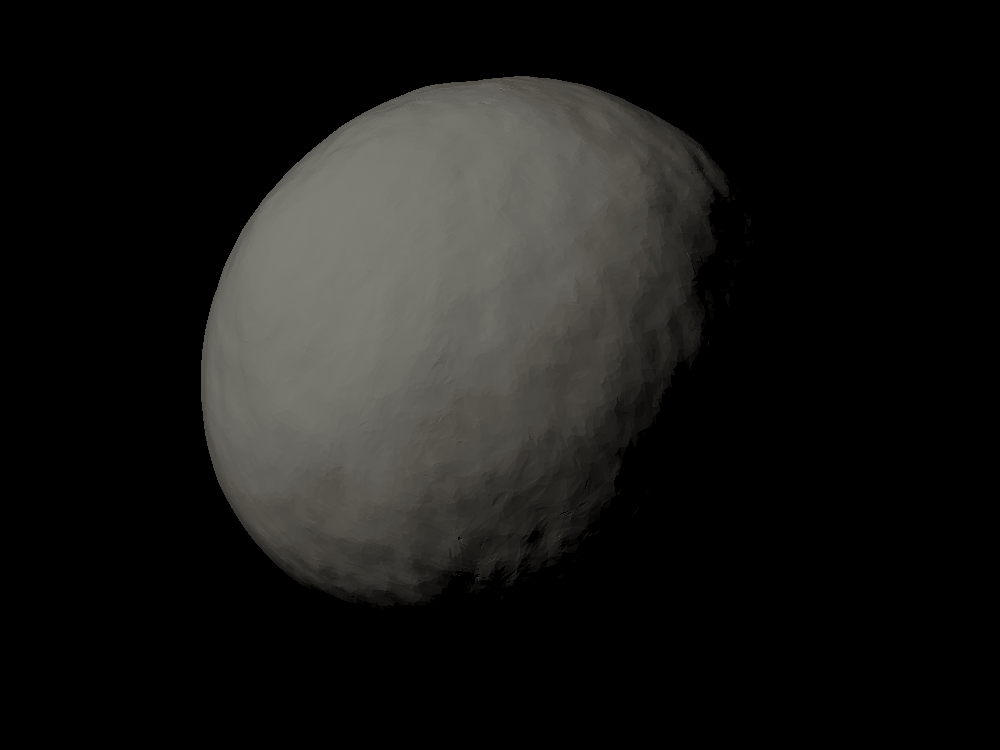
Ganymede with exaggerated topography scaled one in sixty million
prusaprinters
<p>This model was updated using the topographic map present on Steinbrügge (2019), exaggerated 30 times, since Ganymede topography is really flat. It was rendered using MATLAB R2016a.</p><p>The file's names explained: <i>name_1_x_10_y.stl</i> is 1 : x* 10^y. So _1_6_10_7 is 1:600000000 or one in 60 million. </p><h4>J3 Ganymede</h4><p>Ganymede is the largest moon of Jupiter as well as of the Solar System. It's sometime called a "planet like moon", being larger in diameter than <a href="https://www.prusaprinters.org/prints/57282-mercury-with-exaggerated-topography-scaled-one-in-">Mercury</a>, but having a 45% of the planet mass. This is because it's largely composed of water ice, being the largest "icy body" (aka. an object composed of a great fraction of water, with a solid surface). Water is one of the least viscous material of celestial bodies. That's why objects with ice composition can be rounded at smaller size, like <a href="https://www.prusaprinters.org/prints/57256-mimas-scaled-one-in-ten-million">Mimas</a>; or bigger objects like Ganymede can be extremely rounded, because when a moon or an asteroid melts (usually in its early history) it turns into a rounded shape, and a less viscous material could easily flow to fill the irregular terrain. Ganymede has a fully differentiated nucleus, rich in iron, which makes it the only moon with a substantial magnetic field. Its surface has two main types of geography: one old, dark, heavily cratered, similar to that of <a href="https://www.thingiverse.com/thing:3686246">Callisto</a>, and a younger, lighter and grooved terrain. However, this difference is not visible because of the low resolution of the topographical maps. <a href="https://www.prusaprinters.org/prints/57270-io-with-known-topography-scaled-one-in-twenty-mill">Io</a>, <a href="https://www.prusaprinters.org/prints/57273-europa-with-approximate-topography-scaled-one-in-t">Europa</a> and Ganymede are locked in a 1:2:4 orbit resonance, which means that each Ganymede's orbit around Jupiter, Europa makes 2, and Io makes 4.</p><ul><li><strong>Type:</strong> Satellite.</li><li><strong>Orbit:</strong> Jupiter.</li><li><strong>Orbital period:</strong> 7.154 d</li><li><strong>Composition:</strong> Icy body. Differentiated interior. Subsurface ocean.</li><li><strong>Density:</strong> 1.936 g/cm3.</li><li><strong>Dimensions:</strong> 5268.2 km</li><li><strong>Model scale:</strong> 1:6x107 (9cm) 1:1.2x108 (4cm)</li></ul><h4>References</h4><ul><li><a href="https://www.researchgate.net/publication/334610556_Measuring_Ganymede%27s_Librations_with_Laser_Altimetry">Steinbrügge, Gregor & Steinke, Teresa & Thor, Robin & Stark, Alexander & Hussmann, Hauke. (2019). Measuring Ganymede’s Librations with Laser Altimetry. Geosciences. 9. 320. 10.3390/geosciences9070320.</a></li><li><a href="https://www.mathworks.com/matlabcentral/fileexchange/4512-surf2stl">Surf to STL function for MATLAB </a></li></ul><h3>Other astronomical objects</h3><p><a href="https://www.prusaprinters.org/social/120859-tato_713/collections/49826">Inner Solar System</a></p><p><a href="https://www.prusaprinters.org/social/120859-tato_713/collections/49832">Artificial</a></p><p><a href="https://www.prusaprinters.org/social/120859-tato_713/collections/49820">Near Earth Asteroids</a></p><p><a href="https://www.prusaprinters.org/social/120859-tato_713/collections/49291">Main Belt Asteroids</a></p><p><a href="https://www.prusaprinters.org/social/120859-tato_713/collections/49829">Jovian System</a></p><p><a href="https://www.prusaprinters.org/social/120859-tato_713/collections/49828">Saturn System</a></p><p><a href="https://www.prusaprinters.org/social/120859-tato_713/collections/49830">Uranian System</a></p><p><a href="https://www.prusaprinters.org/social/120859-tato_713/collections/49345">Neptunian System</a></p><p><a href="https://www.prusaprinters.org/social/120859-tato_713/collections/49827">Centaurs</a></p><p><a href="https://www.prusaprinters.org/social/120859-tato_713/collections/49833">Comets</a></p><p><a href="https://www.prusaprinters.org/social/120859-tato_713/collections/49341">Trans Neptunian Objects</a></p><p><a href="https://www.prusaprinters.org/social/120859-tato_713/collections/49824">Extrasolar Objects</a></p><p><a href="https://www.prusaprinters.org/social/120859-tato_713/collections/49837">Sky Maps</a></p><p><a href="https://www.prusaprinters.org/social/120859-tato_713/collections/49831">Ancient</a></p><p><a href="https://www.prusaprinters.org/social/120859-tato_713/collections/49822">Speculative</a></p><p><a href="https://www.prusaprinters.org/social/120859-tato_713/collections/49821">Science Fiction</a></p>
With this file you will be able to print Ganymede with exaggerated topography scaled one in sixty million with your 3D printer. Click on the button and save the file on your computer to work, edit or customize your design. You can also find more 3D designs for printers on Ganymede with exaggerated topography scaled one in sixty million.
